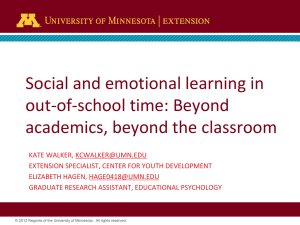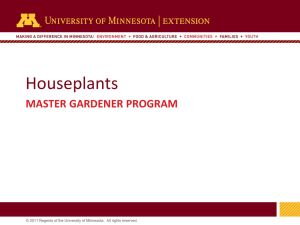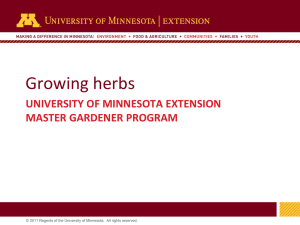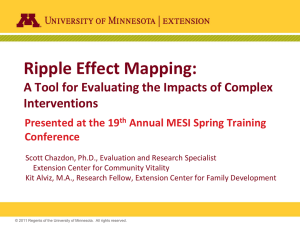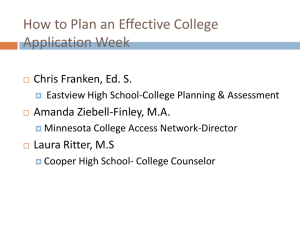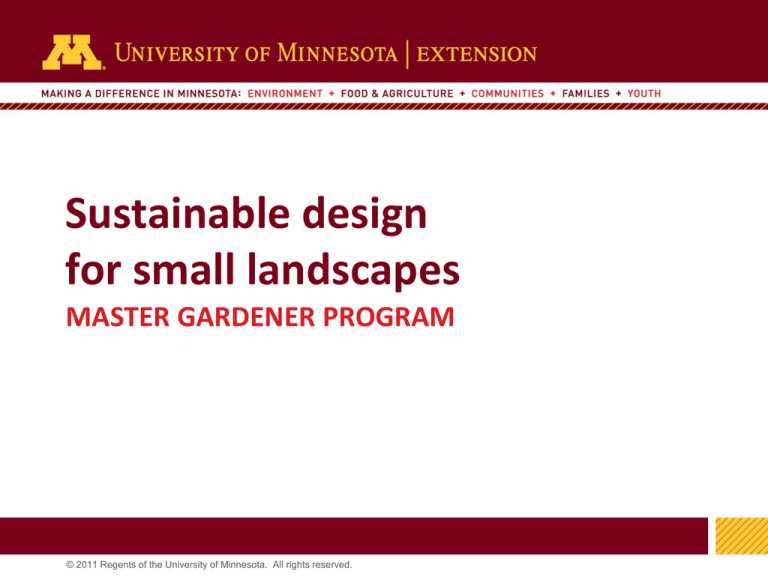
Sustainable design
for small landscapes
MASTER GARDENER PROGRAM
1
© 2011 Regents of the University of Minnesota. All rights reserved.
“… A small plot of ground well ordered,
turns to greater advantage than a large one
neglected …”
- Leonard Meager
The New Art of Gardening, 1697
2
© 2011 Regents of the University of Minnesota. All rights reserved.
Designing small spaces
may feel less
overwhelming
… but more restrictive.
3
© 2011 Regents of the University of Minnesota. All rights reserved.
SUSTAINABLE DESIGN
Designing for plant health and longevity;
Creating “outdoor rooms”;
Important in design regardless of size or
cost.
4
© 2011 Regents of the University of Minnesota. All rights reserved.
FIVE CONSIDERATIONS OF
SUSTAINABLE DESIGN
5
© 2011 Regents of the University of Minnesota. All rights reserved.
1. FUNCTIONAL
6
2. MAINTAINABLE
7
3. ENVIRONMENTALLY SOUND
8
4. COST EFFECTIVE
9
5. VISUALLY PLEASING
10
© 2011 Regents of the University of Minnesota. All rights reserved.
11
© 2011 Regents of the University of Minnesota. All rights reserved.
SITE ANALYSIS: CLIENT INTERVIEW & SURVEY
Client interview
– Activities in the landscape
– Timeline for installation
– Budget – install and maintenance
Site survey
– Site inventory
– Specific, honest evaluation of site features;
measurements
Landscape Design Questionnaire, Site
Evaluation Form
12
© 2011 Regents of the University of Minnesota. All rights reserved.
DESIGN PRINCIPLES
13
© 2011 Regents of the University of Minnesota. All rights reserved.
DESIGN PRINCIPLE 1: UNITY
A feeling of “oneness”
Mix & match plants based on texture, form
Repetition of hardscapes and plants
All aspects should complement one another, not
compete for attention;
The entire design comes together to form one
landscape.
14
© 2011 Regents of the University of Minnesota. All rights reserved.
DESIGN PRINCIPLE 1: UNITY
The entire design:
– Comes together to form
one landscape;
– All aspects should
complement one another,
not compete for attention;
– Repetition of materials
builds unity.
15
© 2011 Regents of the University of Minnesota. All rights reserved.
16
DESIGN PRINCIPLE 2: SIMPLICITY
Large masses and groups
Fewer individual species /
cultivars
Backgrounds, backdrops
Color pallets
1-3 focal points in a small space
More important in commercial
design than residential
17
DESIGN PRINCIPLE 3: VARIETY
Variety in plants: type,
form, texture, seasonal
interest;
Variety in hardscapes:
color, texture
Variety in location:
areas viewed up close,
entry gardens, decks,
walkways, etc.
18
VARIETY VS. COLLECTION
19
© 2011 Regents of the University of Minnesota. All rights reserved.
DESIGN PRINCIPLE 4: BALANCE
Formal vs. informal, symmetrical vs. asymmetrical
20
DESIGN PRINCIPLE 5: EMPHASIS
Integrate focal points,
accent, and specimen
plants in the
landscape
21
DESIGN PRINCIPLE 6: SEQUENCE
The repetition of textures,
colors, form and materials
to transition the viewer
through the landscape.
22
DESIGN PRINCIPLE 7: SCALE
The relative size of one part of a
landscape to another and to human
beings using plants and hard features of
various sizes.
23
PLANT SELECTION
24
© 2011 Regents of the University of Minnesota. All rights reserved.
SELECT PLANTS FOR SUSTAINABILITY
Right plant, right place, right purpose
Select plants based on their elements of
design (characteristics)
– Plant type
– Size
– Form
– Texture
– Seasonal interest
25
© 2011 Regents of the University of Minnesota. All rights reserved.
PLANT SELECTION: PLANT TYPE
26
PLANT SELECTION: SELECT PLANTS BASED
ON MATURE SIZE
27
© 2011 Regents of the University of Minnesota. All rights reserved.
PLANT SELECTION: FORM
28
© 2011 Regents of the University of Minnesota. All rights reserved.
PLANT SELECTION: FORM: GO VERTICAL
29
© 2011 Regents of the University of Minnesota. All rights reserved.
TRELLISING & ESPALIER
30
PLANT SELECTION: TEXTURE, MIX & MATCH
31
PLANT SELECTION: SEASONAL INTEREST
32
COLOR
33
© 2011 Regents of the University of Minnesota. All rights reserved.
COLOR
Warm: Focal point, draws
attention
Cool: Calm, relaxing, larger
Neutral: Transitions, softens,
expands
34
DESIGN TIPS FOR SMALL LANDSCAPES
35
© 2011 Regents of the University of Minnesota. All rights reserved.
1. DESIGN ELEMENTS TO SERVE MORE
THAN ONE PURPOSE
36
2. INTERPLANT ORNAMENTALS
WITH EDIBLES
37
3. CONSIDER VIEWS
38
4. USE TALL PLANTS AS BACKDROPS
39
© 2011 Regents of the University of Minnesota. All rights reserved.
5. DESIGN TURF AREAS FOR MAINTENANCE
Mowing – avoid tight radii
Light & moisture requirements
Repeated traffic, equipment
40
6. AVOID DIVIDING THE PROPERTY
41
7. DE-EMPHASIZE NARROW AREAS
42
© 2011 Regents of the University of Minnesota. All rights reserved.
8. LOCATE DETAILS & VARIETY CLOSE-UP
43
RESOURCES
Sustainable Urban Landscape Information Series (SULIS):
http://www.sustalnd.umn.edu
Gardening Information http://www.extension.umn.edu/gardeninfo
Rice, Graham, The Ultimate Book of Small Gardens
Messervy, Julie Moir and Susanka, Susan, Outside the Not So Big House
Beaulieu, David, “Color Theory in Landscape Design”,
http://landscaping.about.com/od/flowersherbsgroundcover1/a/flower_photos
.htm
Luss, Gunda, “Color Techniques for Landscape Design”
http://www.sustland.umn.edu/design/colortechniques.html
Boulden, Steve, “Big Help for Small Gardens”, http://www.the-landscapedesign-site.com/smallgardens.html
44
© 2011 Regents of the University of Minnesota. All rights reserved.
Discover more at
extension.umn.edu
Created by Julie Weisenhorn, University of Minnesota Extension, Department of Horticultural Science
© 2011 Regents of the University of Minnesota. All rights reserved.
The University of Minnesota is an equal opportunity educator and employer. In accordance with the Americans with Disabilities
Act, this PowerPoint is available in alternative formats upon request. Direct requests to the Extension Store at 800-876-8636.
45

